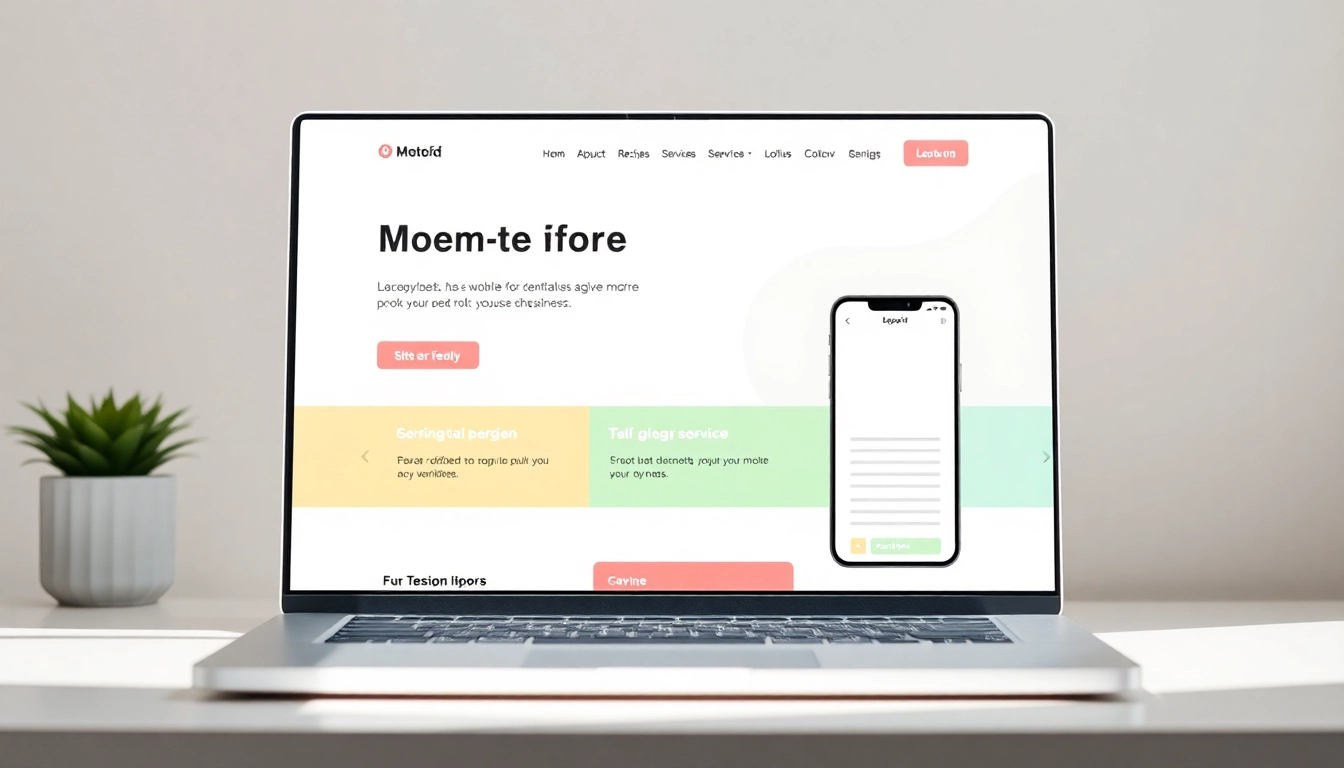Understanding the Essentials of Affordable Web Solutions: Paginas Web Baratas
In today’s digital economy, establishing an online presence is crucial for small businesses and entrepreneurs aiming to compete effectively. The importance of paginas web baratas cannot be overstated—they offer a cost-effective pathway to visibility, customer engagement, and sales. This section explores why affordable web solutions are vital, the key features that make them effective, and the typical challenges faced in developing these economical pages.
1.1 Importance of Affordable Web Solutions for Small Businesses
Small businesses often operate with limited budgets, making high-cost website development financially unfeasible. Affordable web solutions democratize access to professional-quality websites, enabling startups and SMEs to maintain a competitive edge without overspending. By opting for economical options, these businesses can allocate more resources to marketing, product development, or customer service. Additionally, a well-designed budget-friendly website enhances credibility, attracts local and global traffic, and opens opportunities for growth.
1.2 Key Features for Cost-Effective Website Design
Efficient web design hinges on essential features that maximize impact while minimizing expenses. These include responsive design (to ensure functionality across all devices), fast load times, and optimized content for SEO. Leveraging pre-designed templates, minimalistic interfaces, and scalable solutions considerably reduce costs. Moreover, utilizing platforms like WordPress, Wix, or custom templates can streamline development without sacrificing quality, providing a balance between affordability and professionalism.
1.3 Common Challenges in Developing Economical Pages Web
Despite their advantages, creating paginas web baratas presents challenges such as limited customization, potential scalability issues, and compromised functionality if not managed properly. Ensuring security, maintaining performance, and achieving high SEO standards on a tight budget demand careful planning and strategic choices. Overcoming these hurdles involves selecting the right tools, focusing on core features, and planning future upgrades to growth-oriented platforms.
Designing Economical but Professional Paginas Web
Creating affordable yet professional web pages requires a strategic approach that emphasizes cost-efficiency without sacrificing aesthetic appeal or user experience. This section delves into the selection of platforms, responsive design, content optimization, and other best practices that yield high-quality results within budget constraints.
2.1 Choosing the Right Templates and Platforms
The foundation of any economical website is selecting a suitable platform—such as WordPress, Wix, or specialized website builders—that offers ready-to-use templates aligned with your brand identity. Modern platforms provide a wide array of customizable templates that are both professional and affordable. For example, platforms like WebKamy offer pre-designed themes that can be tailored with minimal technical skills, drastically reducing development costs. When choosing templates, prioritize mobile responsiveness, fast loading, and customizable features to ensure versatility and future scalability.
2.2 Responsive Design for All Devices
In an era dominated by mobile browsing, responsive design is non-negotiable. A website must adapt seamlessly to smartphones, tablets, and desktops to provide optimal user experience. Implementing responsive frameworks, such as Bootstrap or Tailwind CSS, allows for flexible layouts that automatically adjust to screen sizes. This not only improves user engagement but also positively influences SEO rankings, as search engines favor mobile-friendly sites. Cost-effective solutions often utilize these frameworks to build responsive interfaces efficiently.
2.3 Incorporating Content Optimization and SEO
Content is the backbone of any website’s success. For economic websites, focusing on content relevance and SEO optimization is vital. Use keyword research tools like Google Keyword Planner to identify relevant keywords, then incorporate them naturally into your content. Publishing high-quality, relevant content not only boosts visibility but also builds authority and trust among visitors. Proper meta tags, descriptive headings, and optimized images further enhance SEO performance without additional costs. Regularly updating your content ensures sustained relevance and search engine rankings.
Implementation Best Practices for Paginas Web Baratas
Building a budget-friendly website involves more than choosing the right colors or templates. It requires strategic decisions on hosting, content creation, speed optimization, and user experience to maximize value. Here, we explore best practices that ensure a professional outcome despite limited resources.
3.1 Selecting Hosting and Domains Economically
Choosing an affordable yet reliable hosting provider is crucial. Companies like IONOS or Hostinger offer plans starting from less than $3 per month, providing ample storage and daily backups ideal for small websites. When selecting a domain, opt for extensions like .com or .net, which are widely recognized, and register through reputable registrars that often run promotions. Bundling hosting and domain registration can lead to significant savings while maintaining performance and security standards.
3.2 Creating Quality, Relevant Content on a Budget
Content creation on a budget leans heavily on strategic planning. Utilize free tools such as Canva for graphics and Grammarly for editing to craft visually appealing and grammatically sound content. Focus on clear, concise messaging that resonates with your target audience. Employee-generated testimonials, customer stories, and FAQs can add value without incurring costs. Moreover, repurposing existing content and aligning it with SEO keywords further amplifies your reach effectively.
3.3 Ensuring Fast Load Times and User Experience
Page speed significantly impacts user retention and SEO. Leverage techniques like image compression (using tools such as TinyPNG), browser caching, and minimizing script loads to optimize performance. Selecting a hosting plan with SSD storage enhances speed, while clean, minimalistic design reduces clutter and load times. A fast, intuitive experience is essential to convert visitors into customers and is achievable without high expenditure by implementing these best practices.
Enhancing Visibility and Conversion with SEO
Even a well-designed website cannot succeed without proper SEO strategies. Small websites relying on paginas web baratas need targeted SEO to attract organic traffic, increase visibility, and generate leads. This chapter discusses local and organic SEO techniques, performance measurement, and ongoing optimization efforts.
4.1 Local and Organic SEO Strategies for Small Websites
Local SEO is particularly beneficial for small businesses aiming to attract nearby customers. Register your site on Google My Business, optimize your NAP (Name, Address, Phone Number), and encourage reviews. For organic SEO, focus on keyword-rich content, productive backlink building, and internal linking. Tools like SEMrush or Ahrefs can guide keyword selection and competitor analysis, ensuring your website ranks higher in search results.
4.2 Key Performance Metrics to Track
Monitoring progress requires analyzing metrics such as organic traffic volume, bounce rate, average session duration, and conversion rates. Google Analytics and Search Console offer detailed insights into user behavior and keyword performance. Regular monitoring allows for data-driven decisions to fine-tune your SEO and content strategies efficiently.
4.3 Continuous Optimization for Long-term Results
SEO is iterative; policies should adapt to changing algorithms and market trends. Updating content, optimizing for new keywords, improving site speed, and securing backlinks are ongoing efforts. Staying informed through industry updates and regularly auditing your website ensures sustained rankings and visibility, making your investment in SEO truly worthwhile over time.
Comparing and Choosing Your Best Paginas Web Economicas
The final step lies in selecting the most suitable and scalable solution aligned with your budget, goals, and growth plans. This section reviews typical price ranges, case studies of successful projects, and advice on future upgrades.
5.1 Price Ranges and Service Offerings
Affordable web services can range from as low as €150 for a one-page site to €350 for a complete website, with some providers offering monthly plans for ongoing support. Basic packages usually include responsive design, SEO optimization, and content management, while premium options might add e-commerce functionalities or advanced analytics. Comparing these allows you to make educated decisions based on features, support, and scalability.
5.2 Case Studies of Successful Affordable Web Projects
For example, a local bakery launched a single-page website for just €150, focusing on high-quality images and SEO-rich content. This generated a 40% increase in booking inquiries within three months. Similar projects demonstrate that well-optimized, professionally designed web pages at affordable prices can produce substantial ROI when strategically implemented.
5.3 Tips for Future Scalability and Upgrades
Start with a scalable platform such as WordPress or Wix, which allows easy addition of pages, e-commerce modules, or advanced functionalities later. Maintain flexibility by choosing hosting plans that support growth, and develop a roadmap for future enhancements based on evolving business needs. Ensuring your website is built on an expandable foundation safeguards your investment and facilitates smoother growth transitions.



